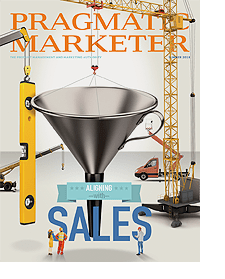
Between us, we have more than three decades of experience running sales organizations and cannot tell you how many times we have sat in meetings and thought, “Man, our marketing team just doesn’t get it.”
Here’s the source of the disconnect: As marketers, it’s your job to influence an entire market of buyers. You need personas to qualify your leads and push them through the funnel. But salespeople don’t pursue an entire market; they go after one account at a time. They just want you to help them win each account. They don’t care about your persona research any more than they care about the ones and zeros in your software code or the nuts and bolts that hold your product together. Frankly, it’s more important to know which IPA their customer drinks and whether it’s consumed during a round of golf.
(Now please don’t go and include beer preferences or any other one-customer-at-a-time details in your persona. You will end up with far too many personas, and your salespeople will hate them all because they know that the information differs for each account.)
Focus on Only Two Personas
Marketing is going after many people in a vast market and sales is going one-to-one. To find the intersection, let us look at an action plan to bridge this gap.
The first step is with personas, but maybe not the way you’re going about it. Salespeople don’t need personas for every title, industry, or other demographic characteristics. In fact, sales alignment requires that you study and build personas for only two types of buyers, the economic decision-maker (EDM) and the lead evaluator. The EDM owns the budget and often triggers the decision to achieve a goal or solve the problem in the account. Sales may tell you that the EDM is the only role that matters, and in many ways, they are right. After all, this persona must say “yes.” But the lead evaluator is the persona who leads the committee for the research and evaluation (hence the lead evaluator label) around all the options in the marketplace.
Yes, your salespeople must satisfy the EDM’s wants, needs, and goals to close the business. But fail to convince the lead evaluator that you are best qualified to deliver on the EDM’s vision, and your competitor will win every time.
Plus, the dirty little secret about building buyer personas is that you can frequently learn everything you need to know by focusing on the lead evaluator. This is the persona that knows what it will take to persuade the EDM to prioritize and approve the investment. Just as critically, the lead evaluator can tell you what all the other stakeholders in the account think about as they argue for their own interests and eventually align around a single provider.
Imagine this: You have a chance to understand the personas’ marketing needs to influence by focusing first on only one persona, the lead evaluator. Find people in this role and interview them carefully about their recent buying decision. You’ll get the whole story behind the trigger for the evaluation, the success factors they were seeking, the obstacles they faced, the criteria the committee used to compare their options, and the resources they trusted throughout their buying journey.
Now you have a dialogue worth analyzing and personifying, one that aligns both marketing and sales around what you need to do and say to win the account. That’s step one.
Add One Map of the Buyer’s Journey
The second step is to align around what buyers told you about their journey. Instead of asking salespeople to rally around your marketing map, or trying to use theirs to drive your activities (neither works), rally around how to persuade buyers to take action and choose you. Your mutual goal is singular and well defined because it’s the buyer’s map; sales and marketing can then focus on delivering what real buyers want to hear, how and when they want to hear it.
Your interviews with the lead evaluator will reveal every aspect of what matters during the buyer’s journey, including the actual questions buyers ask the market. You’ll want to align those questions with the stages of a mutually agreed-upon funnel, using a format that your salespeople are accustomed to.
Mapping your buyer’s wants and needs to this buying journey will allow everyone on both teams to align—once and for all—around who is saying what, when, and why. For example, if sales sees that you have created a video to answer a question at the top of the funnel that sales thinks should be addressed, they will believe that your two teams are aligned. Equally important, you will know what buyers are asking near the latter parts of the journey (when sales is working the account), and if they ask for your help, you will understand the need so you can deliver the maximum value.
Develop Your Messaging Themes
The final and crucial point of alignment is using your personas and journey maps to build out your message themes. If you reflect on the work you did to interview buyers about their wants, needs, and concerns, you’ll see that you now understand their questions. Plus, because you’ve mapped the buyer’s journey, you know when those questions occur along the buying journey and where buyers are looking for useful information.
Messaging is a critical step where you gain alignment and act on your personas. Set up a time to work with sales. Reflect on each of your persona’s questions and agree on exactly what you will say. This is a surprisingly enlightening experience for everyone. As a team, you see where your capabilities align with what your buyers want. You’ll also see where you might fall short of their expectations, which may result in plans to adjust the solution roadmap or develop objection busters.
Identify your top message themes to engage buyers and drive their consideration in areas where your answers are a perfect match with the buyer’s questions. We call these value wedges because even though they don’t tell your whole story, these wedges are built to fit perfectly into cracks in your buyer’s granite wall of resistance. Your next step is to drive the wedges deeper into those cracks so you can explain your complete value proposition.
Align on a Plan to Win More Business
The inevitable result of collaboration between sales, marketing, and your personas is that each role has a single source for creating exactly what they need to communicate at each touchpoint along the journey. You’ve looked honestly at the facts about areas where your company excels, married that with the questions your buyers are asking (instead of sales, marketing, or executive opinion), and agreed on what you should say to the market.
Align these messages along with the journey map and give your team clarity about what they need to say and do, and when. For example, sales should use buyer questions and answers to create sales playbooks. In addition, sales-development reps should create strong qualifying questions and the entire marketing team should focus on what’s required to build demand and conversion action plans.
When your sales and marketing teams focus on a plan to influence two buyers and one journey, you can finally eliminate misalignment, your biggest obstacle to revenue growth. What’s more, you’ll position your company to deliver the best buying experience to your market and win more business.
Authors
-

-

Brock Flint is the chief strategy officer of Buyer Persona Institute. Over the past 20 years, Brock has held numerous leadership roles in sales, marketing and customer success in the public and private sectors. For the past decade, he has been on the founding team of three successful early-stage ad-tech startups, leading each in the areas of revenue growth, product-market fit and overall strategic direction. Learn more at buyerpersona.com or connect with him at linkedin.com/in/brockflint.








